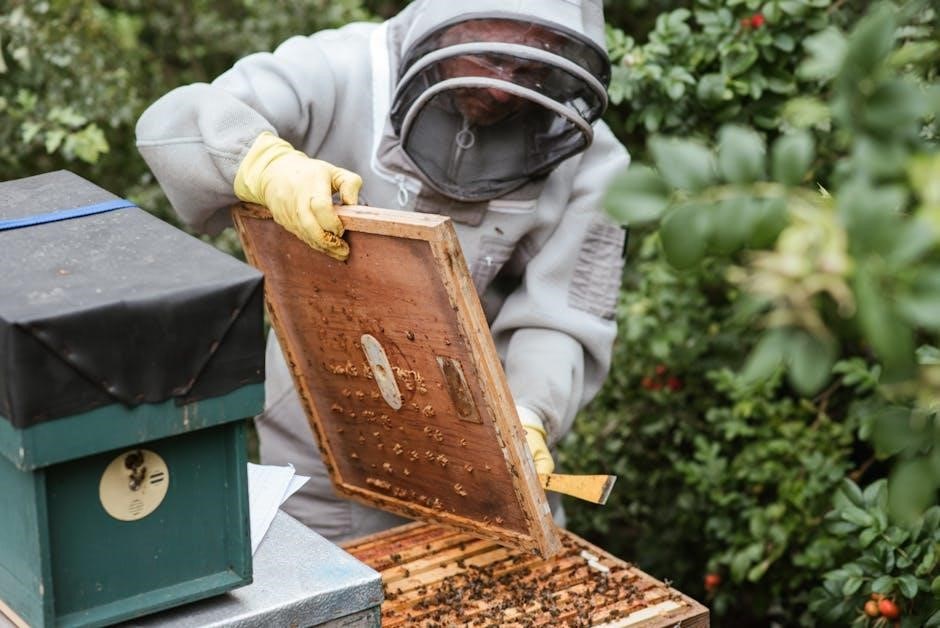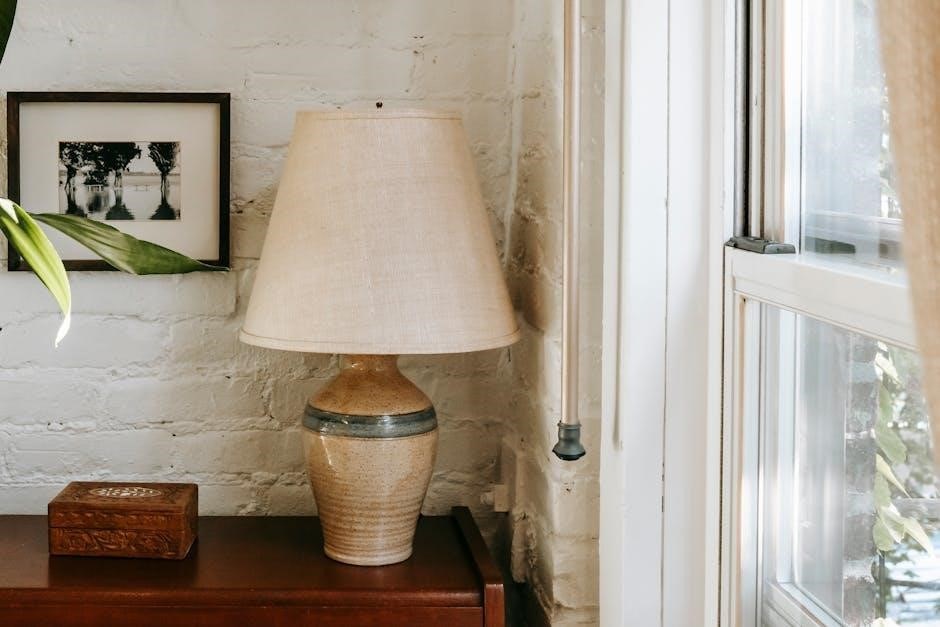A 5-frame NUC (Nucleus Colonies) box is a compact, portable beekeeping solution ideal for small colonies, swarm management, and hive splitting. Designed for efficiency, these boxes use high-quality wood and precise dimensions to ensure hive health. PDF plans provide detailed blueprints, making DIY construction accessible for beekeepers of all skill levels. Perfect for space-saving and easy handling, 5-frame NUC boxes are a popular choice for modern beekeeping practices.
Overview of NUC Boxes in Beekeeping
NUC (Nucleus Colonies) boxes are essential tools in modern beekeeping, serving as compact, portable hives for managing small bee colonies. They are widely used for swarm control, hive splitting, and raising new queens. A 5-frame NUC box is particularly popular due to its space efficiency and ease of handling. These boxes provide adequate room for colony growth while maintaining simplicity. Beekeepers often utilize downloadable PDF plans to construct their own NUC boxes, ensuring durability and customization. This approach supports sustainable beekeeping practices and colony health.
Importance of 5-Frame NUC Boxes
5-frame NUC boxes are indispensable for beekeepers due to their versatility and practicality. They are ideal for managing small colonies, controlling swarms, and raising queens. Their compact size makes them portable and easier to handle, especially for beginners. These boxes provide sufficient space for colony growth while minimizing resource use. Using PDF plans ensures precise construction, allowing beekeepers to customize the design. This cost-effective solution supports sustainable beekeeping and promotes healthy colony development, making 5-frame NUC boxes a valuable asset for beekeepers of all levels.
Benefits of Using PDF Plans for NUC Boxes
PDF plans for 5-frame NUC boxes offer numerous advantages for beekeepers. They provide precise measurements and detailed instructions, ensuring accurate construction. PDFs are easily downloadable and printable, making them accessible and portable. These plans often include diagrams and layouts, simplifying the assembly process. They also allow for customization, enabling beekeepers to adapt designs to their needs. Using PDF plans saves time and reduces errors, making them a reliable and cost-effective resource for building NUC boxes efficiently and effectively.

Understanding the Components of a 5-Frame NUC Box
A 5-frame NUC box includes a brood nest box, inner cover, vent box, and outer cover, each designed to support hive health and productivity efficiently.
Brood Nest Box Dimensions and Frame Capacity
The brood nest box typically measures 6.25 inches in height, 7.625 inches in width, and 12 inches in length, designed to hold five frames securely. This compact size ensures optimal space for the colony to grow without overcrowding. The dimensions are carefully calculated to accommodate the natural expansion of the hive, ensuring proper ventilation and temperature regulation. These measurements are critical for maintaining colony health and productivity, especially for nucleus colonies in early stages of development.
Inner Cover and Vent Box Design
The inner cover and vent box are crucial for regulating hive conditions. The inner cover is typically made of 1/8-inch plywood, fitting snugly over the brood nest box. It features ventilation slots to promote airflow and moisture removal. The vent box, often integrated into the design, includes screened or slotted openings to enhance air circulation while preventing pests from entering. These components work together to maintain a healthy environment, ensuring proper temperature and humidity levels within the hive.

Outer Cover and Overall Box Structure
The outer cover is designed to protect the hive from environmental elements, typically made from durable materials like 1/4-inch or 1/2-inch plywood. It features a sloped roof to shed water and snow effectively. The overall box structure is reinforced with screws or nails for stability. Handles or grips are often added for easy transport. The design ensures the hive remains dry, secure, and well-insulated, promoting a healthy environment for the bees while withstanding outdoor conditions year-round.

Tools and Materials Required
Tools: Circular saw, drill, hammer, tape measure, square, and screwdriver. Materials: Pine or cedar wood, plywood, nails, screws, glue, and waterproof sealant for durability and protection.
Wood and Plywood Specifications
For a 5-frame NUC box, use durable, rot-resistant wood like pine or cedar. The brood nest box typically requires 1″ thick wood for the sides and back. The bottom and inner cover can be 3/4″ thick. Plywood (3/8″ thick) is ideal for the floor to prevent warping. Ensure all materials are free of knots and treated for weather resistance. Avoid using pressure-treated wood to prevent chemical contamination. Sand all surfaces for a smooth finish and apply a waterproof sealant or paint for longevity.
Essential Tools for Cutting and Assembly
To build a 5-frame NUC box, you’ll need a circular saw for cutting wood, a drill press for precise holes, and a jigsaw for curved cuts. A tape measure, square, and clamps ensure accuracy and alignment. Safety glasses and a dust mask are crucial for protection. Sandpaper smooths edges, while a hammer and screwdriver secure parts. Optional tools include a router for finishing touches and an impact driver for faster assembly. Organize your tools beforehand for efficiency.
Fasteners and Adhesives Needed
For assembling a 5-frame NUC box, you’ll need 1-1/4” wood screws for frame assembly and 1-1/2” screws for box construction. Nails, such as 1” or 1-1/2” galvanized, are ideal for securing outer covers. Wood glue ensures strong joints, while exterior-grade caulk seals gaps. Hinges and latches are essential for the outer cover. Use weather-resistant fasteners to protect against moisture. Proper adhesion and secure fastening ensure durability and longevity of the NUC box in various environmental conditions.

Step-by-Step Guide to Building a 5-Frame NUC Box
- Follow detailed PDF plans for precise measurements and cuts.
- Cut wood according to specified dimensions for each component.
- Assemble the brood nest box and attach frames securely.
- Install the inner cover and vent box for proper ventilation.
- Attach the outer cover and ensure all components are aligned.
- Finish with sanding and optional painting for weather protection.
Cutting the Wood According to Plans
Cutting wood accurately is crucial for building a 5-frame NUC box. Use the PDF plans to measure and mark each piece carefully. Ensure all cuts are precise to fit together seamlessly. Start with the brood nest box, cutting the sides, back, and front panels. Next, cut the frames and frame spacers. Use a saw or CNC machine for clean edges. Sand all cut surfaces to prevent splinters. Double-check measurements to avoid errors during assembly. Safety goggles and proper tools are essential for this step.
Assembling the Brood Nest Box
Assembling the brood nest box begins with aligning the pre-cut sides, back, and front panels according to the PDF plans. Use wood glue and screws to secure the joints, ensuring the corners are square and the structure is sturdy. Attach the base to the sides, followed by the back and front panels, making sure they fit snugly. Install frame spacers to maintain proper spacing for the frames. Sand all surfaces for a smooth finish and inspect for any gaps or weaknesses. This step ensures a solid foundation for your 5-frame NUC box.
Attaching the Inner Cover and Vent Box
Attach the inner cover by aligning it with the brood nest box edges, ensuring a snug fit. Secure it using small screws or nails, avoiding overtightening to prevent warping. Next, place the vent box on top of the inner cover, aligning the pre-drilled holes. Use screws to fasten it firmly, creating a seamless connection. This setup enhances airflow and moisture control, maintaining a healthy environment for the bees; Proper alignment is crucial to ensure the hive remains dry and functions efficiently.
Securing the Outer Cover
Attach the outer cover by aligning it with the top edges of the NUC box. Use weather-resistant screws to secure it firmly, ensuring a tight seal; Install hinges on one side for easy access and a latch or lock on the other for security. Apply a thin layer of weatherproof sealant around the edges to prevent moisture entry. Ensure the cover is snug but not overly tight, allowing easy removal for inspections. This step protects the hive from elements and pests, maintaining a safe environment for the bees while ensuring durability and accessibility for beekeepers.

Installing Frames and Foundation
Place frames inside the NUC box, ensuring proper spacing. Attach wax or plastic foundation to frames using nails or clips. Align frames straight for even comb building.
Preparing Frames for the NUC Box
Start by cleaning frames with alcohol to remove old wax and debris. Attach wax or plastic foundation using frame nails or clips for secure fitting. Ensure frames are evenly spaced, typically 1.25 inches apart, to accommodate proper comb building. Handle frames gently to avoid damage. Use a frame grip or hive tool for easy manipulation. Properly prepared frames promote healthy brood development and organized hive structure, essential for thriving colonies.
Adding Wax or Plastic Foundation
Securely attach wax or plastic foundation to frames using frame nails or clips. Wax foundation is ideal for natural comb building, while plastic is durable and easy to clean. Start by placing the foundation evenly across the frame, ensuring it aligns with pre-drilled holes. Gently hammer nails to avoid damaging the foundation. For plastic, ensure it fits snugly into the frame’s grooves. Properly attached foundation helps bees build combs efficiently and maintains hive organization.
Ensuring Proper Frame Spacing
Proper frame spacing is crucial for bee health and hive efficiency. In a 5-frame NUC box, frames should be spaced 1.5 inches apart to allow easy movement for bees. Consistent spacing prevents overcrowding and disease, while also ensuring efficient comb building. Use spacers or precise measurements to maintain uniformity. Proper spacing facilitates worker bees’ tasks like nectar collection and brood rearing. Standard 1.5-inch spacing is recommended for optimal bee movement and hive functionality.

Seasonal Considerations and Maintenance
Seasonal adjustments ensure hive health. Insulate in winter, enhance ventilation in summer, and maintain humidity control. Regular inspections and cleaning are vital for optimal bee productivity year-round.
Winter Preparation for NUC Boxes
Winter preparation is crucial for maintaining healthy bee colonies in 5-frame NUC boxes. Ensure proper insulation to retain heat and protect from harsh winds. Reduce entrances to minimize cold air infiltration and moisture buildup, which can lead to disease. Provide adequate food stores, as bees consume more resources during colder months. Regularly inspect for signs of pests or weakness, and consider clustering colonies for shared warmth. Proper winter care ensures colony survival until spring.
Summer Management Tips
Effective summer management is essential for thriving 5-frame NUC boxes. Monitor temperature fluctuations and ensure proper ventilation to prevent overheating. Provide a consistent water source to support hydration and honey production. Regularly inspect for pests like mites or small hive beetles. Control swarming by adding supers or splitting strong colonies. Maintain frame spacing to prevent overcrowding. Harvest honey responsibly, leaving enough for the bees. Keep the box clean and well-maintained to promote colony health and productivity during peak season.
Regular Inspections and Repairs
Regular inspections are vital to ensure the health and longevity of your 5-frame NUC box. Check for signs of wear, damage, or pest infestations monthly. Repair any cracks or gaps promptly to maintain structural integrity. Use a hive tool to scrape off excess wax or debris. Replace worn-out frames or foundation as needed. Ensure the box remains clean and well-ventilated. Addressing issues early prevents larger problems and keeps your colony thriving. Regular maintenance is key to a successful beekeeping experience.

Additional Resources and Diagrams
Downloadable PDF plans provide detailed cutting layouts and assembly instructions. Includes diagrams for frame spacing, vent box construction, and outer cover installation. Photos illustrate each step.
Downloadable PDF Plans and Blueprints
High-quality PDF plans provide precise measurements and detailed diagrams for constructing a 5-frame NUC box. These blueprints include a cutting list, assembly instructions, and frame spacing guidelines. They are scalable and suitable for both experienced and novice beekeepers. The plans often come with optional customizations to adapt the design for specific needs. Ensure the PDF includes clear dimensions and material requirements for accurate construction. Always verify the source for updated versions to avoid errors.
Cutting Layout Diagrams
Cutting layout diagrams provide a visual guide for precise wood cuts, ensuring accurate assembly of the 5-frame NUC box. These diagrams detail where to make cuts on each piece of wood, optimizing material use. They often include measurements for brood boxes, inner covers, and outer covers. Use these diagrams to avoid errors and ensure all components fit seamlessly together. Always cross-reference with the PDF plans for consistency and accuracy during the cutting process.
Photos and Assembly Instructions
Photos and assembly instructions are crucial for constructing a 5-frame NUC box. High-quality images provide a clear visual reference, while step-by-step instructions guide you through each stage. These resources ensure that even novice beekeepers can assemble the box accurately. Look for detailed photos showing frame placement, cover installation, and box alignment. Instructions often include troubleshooting tips to address common issues, helping you achieve a professional finish and a functional hive for your bees.

Safety Tips and Best Practices
Always wear protective gear like gloves, safety glasses, and a dust mask. Use sharp tools carefully and maintain a clean workspace. Ensure proper ventilation when using adhesives.
Handling Tools and Wood Safely
Always handle sharp tools with care to avoid injuries. Use protective gloves and safety glasses when cutting or assembling wood. Keep tools sharp for better control and precision. Store tools in a dry place, out of reach of children. Inspect wood for splinters or nails before handling. Lift planks correctly to avoid strain. Ensure proper ventilation when sanding to prevent inhaling dust. Keep the workspace clean to minimize accidents and maintain focus.
Protective Gear Recommendations
Always wear safety glasses and a dust mask when cutting or sanding wood to protect against debris. Use sturdy gloves to prevent splinters and improve grip. Steel-toe boots are essential for protecting feet from heavy tools or falling objects. Consider wearing a long-sleeved shirt and tie-back pants to avoid injuries from sharp edges. Ensure all protective gear fits properly and is in good condition for maximum safety. Proper attire helps prevent accidents and ensures a safe building experience.
Avoiding Common Mistakes
Ensure accurate measurements to avoid misfits in frame slots or box dimensions. Double-check cuts before assembly to prevent costly errors. Avoid rushing the assembly process, as this can lead to structural weaknesses. Properly seal gaps between components to prevent pest entry. Use high-quality materials to ensure durability and longevity. Follow the PDF plans closely to maintain proper frame spacing and box proportions. Avoiding these mistakes ensures a sturdy, functional NUC box for healthy bee colonies;

Comparison with Other NUC Box Sizes
The 5-frame NUC box offers a balanced approach, providing ample space for colony growth while maintaining portability and cost-efficiency compared to larger or smaller NUC sizes.
Advantages of 5-Frame vs. Larger NUCs
The 5-frame NUC box offers superior portability and cost-efficiency compared to larger sizes. It requires less material for construction and maintains healthier colony temperatures. With reduced space, beekeepers can manage resources more effectively, ensuring optimal hive condition. This size is ideal for small-scale beekeeping and nucleus colony growth, making it a practical choice for both beginners and experienced beekeepers seeking a balanced approach to hive management.
Space and Portability Considerations
The 5-frame NUC box is designed to optimize space, making it ideal for beekeepers with limited area. Its compact size allows for easier transportation between locations. This portability is especially beneficial for managing multiple colonies. The smaller footprint also simplifies storage during off-seasons. For new beekeepers, this size is manageable and scalable, promoting efficient hive management without overwhelming resources.
Cost-Effectiveness Analysis
The 5-frame NUC box offers significant cost savings compared to larger models. Its smaller size reduces material expenses, with less wood and hardware required. This makes it an economical choice for beekeepers, especially those managing multiple colonies. Additionally, the lower frame count decreases the cost of foundations and frames. While larger NUCs may offer scalability, the 5-frame box balances affordability with functionality, making it a practical option for beekeepers seeking efficiency without excessive upfront investment.
Building a 5-frame NUC box is a rewarding project, offering beekeepers an efficient and cost-effective solution. Ideal for both novices and experienced beekeepers, it ensures easy management and scalability.
Building a 5-frame NUC box involves precise cutting, assembly, and attention to detail. Start by preparing materials and tools, ensuring all measurements match the PDF plans. Assemble the brood nest box first, then attach the inner cover and vent box. Secure the outer cover tightly for durability. Proper frame spacing and foundation installation are crucial for bee health. Seasonal maintenance, like winter preparation, is essential for colony survival. Always follow safety guidelines and inspect regularly for repairs. New beekeepers should practice patience and seek guidance to ensure success.
Encouragement for First-Time Builders
Welcome to the world of beekeeping and woodworking! Building a 5-frame NUC box is a rewarding project, even for beginners. With clear PDF plans, you’ll find the process manageable and enjoyable. Don’t be intimidated—take it one step at a time and embrace the learning experience. Patience and attention to detail will yield a sturdy, functional box for your bees. Remember, every beekeeper started somewhere, and this is a great way to grow your skills. Good luck, and enjoy the journey!
Importance of Proper Assembly
Proper assembly of your 5-frame NUC box is crucial for the health and safety of your bees. A well-constructed box ensures structural integrity, protecting the colony from environmental stressors like moisture and pests. Accurate alignment of frames and components prevents gaps that could harm the bees or disrupt hive activity. Follow the PDF plans carefully to guarantee a sturdy, functional box that supports proper ventilation and frame spacing. Your attention to detail will directly impact the success of your beekeeping efforts.